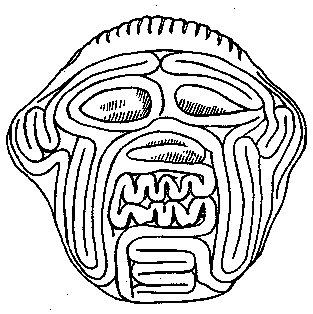|
THE D
TABLET
Once again. I suggest the creator of the text intended it should be counted (it should be perceived, it should be read) that there were 8 days from Db4-1 (→ 41 Arietis = Bharani) to Db4-9 (177 + 2 = 179, where the first of a pair of hetuu (one for each halfyear) was depicted up in front. ... In north Asia the common mode of reckoning is in half-year, which are not to be regarded as such but form each one separately the highest unit of time: our informants term them 'winter year' and 'summer year'. Among the Tunguses the former comprises 6½ months, the latter 5, but the year is said to have 13 months; in Kamchatka each contains six months, the winter year beginning in November, the summer year in May; the Gilyaks on the other hand give five months to summer and seven to winter. The Yeneseisk Ostiaks reckon and name only the seven winter months, and not the summer months. This mode of reckoning seems to be a peculiarity of the far north: the Icelanders reckoned in misseri, half-years, not in whole years, and the rune-staves divide the year into a summer and a winter half, beginning on April 14 and October 14 respectively. But in Germany too, when it was desired to denote the whole year, the combined phrase 'winter and summer' was employed, or else equivalent concrete expressions such as 'in bareness and in leaf', 'in straw and in grass' ... From Db4-9 (→ 4 * 9 = 36) and to the end of line Db4 there were 7 glyphs which might correspond to the 7 'explorers' (planets) in Manuscript E. 359 + 7 = 366. ... Hau Maka spoke to his first-born son [atariki] Ira, to Raparenga, and also to the sons of Hua Tava - namely, Kuukuu A Hua Tava, Ringiringi A Hua Tava, Nonoma A Hua Tava, Uure A Hua Tava, and Makoi A Hua Tava. Hau Maka said [he ki] to [kia] Ira: 'Take the crew and launch your canoe; set sail and look for the land in the direction of the rising sun (a roto i te raa) ... [E:15]
When Mimosa was at the Full Moon we can imagine this to be a Sign of 'only partially visible', which could explain why the last glyph in line Db2 and the first glyph in line Db3 were drawn thus:
And then we can count from Db2-1 (143) to Db3-1 by adding 13 and find Db3-1 to be glyph number 156. And by adding 13 to March 17 (77) we will find March 30 at Db3-1. However, March 30 is not day 90 but day 89. Maybe this phenomenon initiated the name Mimosa. In my overall view above I have stated that March 31 is day number 90 and that Db3-1 is glyph number 156.
And the same kind of phenomenon returns here:
Could the creator of the D text have tried to illustrate the fact that the synodic lunar cycle is 29½ nights long? Or was he afraid of Enoch's curse: ... The author of the Book of Enoch in his treatise on astronomy and the calendar also reckoned a year to be 364 days, though he pronounced a curse on all who did not reckon a month to be 30 days long ...
... Ganz ähnlich is der Name 'Gott von Duazag' des Gottes Nabū ... zu erklären. Er bezeichnet ihn als den Gott des Wachtstums, welches als aus dem Osten stammend betrachtet wird, weil die Sonne, die das Wachstum bringt, im Osten aufgeht. Dass aber Nabū als Ost-Gott aufgefasst wurde, hängt damit zusammen, dass sein Stern, der Mercur, nur im Osten oder Westen sichtbar ist ... ... Another name for Mercury was Hermes and Hermes Trismegisthos (thrice-mighty) could have referred to the fact that there were 3.141 * 115.88 = 364.0 days for the cycle of the Earth around the Sun. Although the calendar has 365 days for a year this is due to the fact that the Earth has to turn around an extra day in order to compensate for how the direction to the Sun changes during a year ...
|
||||||||||||||||||||||||||||||||||||||||||||||||||||||||||||||||||||||||||||||||||||||||||||||||||||||||||||||||||||||||||||||||||||||||||||||||||||||||||||||||||||||||||||||||||||||||||||||||||||||||||||||||||||||||||||||||||||||||||||||||||||||||||||||||||||||||||||||||||||||||||||||||||||||||||||||||||||||||||||||



















